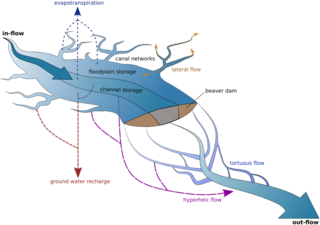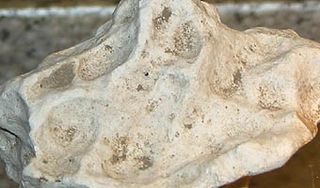Related Research Articles

In classical soil science, humus is the dark organic matter in soil that is formed by the decomposition of plant and animal matter. It is a kind of soil organic matter. It is rich in nutrients and retains moisture in the soil. Humus is the Latin word for "earth" or "ground".

Soil pH is a measure of the acidity or basicity (alkalinity) of a soil. Soil pH is a key characteristic that can be used to make informative analysis both qualitative and quantitatively regarding soil characteristics. pH is defined as the negative logarithm (base 10) of the activity of hydronium ions in a solution. In soils, it is measured in a slurry of soil mixed with water, and normally falls between 3 and 10, with 7 being neutral. Acid soils have a pH below 7 and alkaline soils have a pH above 7. Ultra-acidic soils and very strongly alkaline soils are rare.

Wilting is the loss of rigidity of non-woody parts of plants. This occurs when the turgor pressure in non-lignified plant cells falls towards zero, as a result of diminished water in the cells. Wilting also serves to reduce water loss, as it makes the leaves expose less surface area. The rate of loss of water from the plant is greater than the absorption of water in the plant. The process of wilting modifies the leaf angle distribution of the plant towards more erectophile conditions.
Soil moisture is the water content of the soil. It can be expressed in terms of volume or weight. Soil moisture measurement can be based on in situ probes or remote sensing methods.

Ecohydrology is an interdisciplinary scientific field studying the interactions between water and ecological systems. It is considered a sub discipline of hydrology, with an ecological focus. These interactions may take place within water bodies, such as rivers and lakes, or on land, in forests, deserts, and other terrestrial ecosystems. Areas of research in ecohydrology include transpiration and plant water use, adaption of organisms to their water environment, influence of vegetation and benthic plants on stream flow and function, and feedbacks between ecological processes, the soil carbon sponge and the hydrological cycle.

Water content or moisture content is the quantity of water contained in a material, such as soil, rock, ceramics, crops, or wood. Water content is used in a wide range of scientific and technical areas, and is expressed as a ratio, which can range from 0 to the value of the materials' porosity at saturation. It can be given on a volumetric or mass (gravimetric) basis.
In soil science, pedotransfer functions (PTF) are predictive functions of certain soil properties using data from soil surveys.

Sepiolite, also known in English by the German name meerschaum ( MEER-shawm, -shəm; German: [ˈmeːɐ̯ʃaʊm](listen); meaning "sea foam"), is a soft white clay mineral, often used to make tobacco pipes (known as meerschaum pipes). A complex magnesium silicate, a typical chemical formula for which is Mg4Si6O15(OH)2·6H2O, it can be present in fibrous, fine-particulate, and solid forms.
Lorenzo Adolph Richards or known as Ren was one of the 20th century's most influential minds in the field of soil physics.
Field capacity is the amount of soil moisture or water content held in the soil after excess water has drained away and the rate of downward movement has decreased. This usually takes place 2–3 days after rain or irrigation in pervious soils of uniform structure and texture. The physical definition of field capacity is the bulk water content retained in soil at −33 kPa of hydraulic head or suction pressure. The term originated from Israelsen and West and Frank Veihmeyer and Arthur Hendrickson.
Moisture equivalent is proposed by Lyman Briggs and McLane (1910) as a measure of field capacity for fine-textured soil materials. Moisture equivalent is defined as the percentage of water which a soil can retain in opposition to a centrifugal force 1000 times that of gravity. It is measured by saturating sample of soil 1 cm thick, and subjecting it to a centrifugal force of 1000 times gravity for 30 min. The gravimetric water content after this treatment is its moisture equivalent. This concept is no longer used in soil physics, replaced by field capacity.

Permanent wilting point (PWP) or wilting point (WP) is defined as the minimum amount of water in the soil that the plant requires not to wilt. If the soil water content decreases to this or any lower point a plant wilts and can no longer recover its turgidity when placed in a saturated atmosphere for 12 hours. The physical definition of the wilting point, symbolically expressed as θpwp or θwp, is said by convention as the water content at −1,500 kPa (−15 bar) of suction pressure, or negative hydraulic head.
The non-limiting water range (NLWR) represents the range of water content in the soil where limitations to plant growth are minimal. John Letey (1985) from UC Riverside introduced the NLWR concept in an attempt to integrate several physical properties associated with plant or root growth to refine the concept of available water capacity. Alvaro Pires da Silva, Bev Kay, and Ed Perfect (1994) refined the concept and termed it least limiting water range (LLWR).
Moisture stress is a form of abiotic stress that occurs when the moisture of plant tissues is reduced to suboptimal levels. Water stress occurs in response to atmospheric and soil water availability when the transpiration rate exceeds the rate of water uptake by the roots and cells lose turgor pressure. Moisture stress is described by two main metrics, water potential and water content.

A lysimeter is a measuring device which can be used to measure the amount of actual evapotranspiration which is released by plants. By recording the amount of precipitation that an area receives and the amount lost through the soil, the amount of water lost to evapotranspiration can be calculated. Lysimeters are of two types: weighing and non-weighing.

Agricultural soil science is a branch of soil science that deals with the study of edaphic conditions as they relate to the production of food and fiber. In this context, it is also a constituent of the field of agronomy and is thus also described as soil agronomy.

Soil respiration refers to the production of carbon dioxide when soil organisms respire. This includes respiration of plant roots, the rhizosphere, microbes and fauna.
Soils can process and hold considerable amounts of water. They can take in water, and will keep doing so until they are full, or until the rate at which they can transmit water into and through the pores is exceeded. Some of this water will steadily drain through the soil and end up in the waterways and streams, but much of it will be retained, despite the influence of gravity. Much of this retained water can be used by plants and other organisms, also contributing to land productivity and soil health.

Soil moisture sensors measure the volumetric water content in soil. Since the direct gravimetric measurement of free soil moisture requires removing, drying, and weighing of a sample, soil moisture sensors measure the volumetric water content indirectly by using some other property of the soil, such as electrical resistance, dielectric constant, or interaction with neutrons, as a proxy for the moisture content.
Breeding for drought resistance is the process of breeding plants with the goal of reducing the impact of dehydration on plant growth.
References
- ↑ Richards, L.A.; Wadleigh, C.H. (1952). "Soil water and plant growth". In B.T. Shaw (ed.). Soil Physical Conditions and Plant Growth. American Society of Agronomy Series Monographs, Volume II. New York: Academic Press. pp. 74–251.
- ↑ Duncan, Maurice; Davoren, Anthony; Carrick, Sam; Ellery, Glenn; Stevenson, Peter; Stewart, Doug (June 2013). Soil Water Measurement: Measurement, Processing and Archiving of Soil Water Content Data (PDF) (Report). 1.0. National Environmental Monitoring Standards. p. ii.
- ↑ Veihmeyer, F.J.; Hendrickson, A.H. (1927). "The relation of soil moisture to cultivation and plant growth". Proc. 1st Intern. Congr. Soil Sci. 3: 498–513.
- ↑ Richards, L.A. (1928). "The usefulness of capillary potential to soil moisture and plant investigators". J. Agr. Res. 37: 719–742.
- ↑ Francis, Michele Louise (2019). "Effect of sepiolite and palygorskite on plant available water in Arenosols of Namaqualand, South Africa". Geoderma Regional. 17: e00222. Bibcode:2019GeodR..1700222F. doi:10.1016/j.geodrs.2019.e00222. S2CID 133773908.